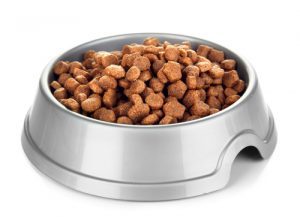Food Mites in the Dog’s Food!
By Chris Williams on January 11, 2012.
Q. When I emptied a bag of dry dog food yesterday I noticed tiny moving things in the bottom of the bag. You could barely see them. It looked like the leftover dog food dust was moving. Are these some kind of mite? Will it hurt my dog if he ate them?
A. You probably did find evidence of some type of grain mite in the dog food. Grain mites are just one type of food mite. Food mites are associated with high humidity and old foods that have become moldy. I’m guessing that the bag of dog food might have been around for awhile and that it was stored in a damp location like the basement or garage.
 Food mites are so tiny that they are usually first noticed by their movement. In heavy infestations, the infested grain or food product seems to be rippling in waves. You’ll notice a light brown powder in corners, on top of, or underneath packaging. The powder is made up of live mites, dead mites, shed skins, and mite feces. Mite-infested food also has a sweet, minty smell.
Food mites are so tiny that they are usually first noticed by their movement. In heavy infestations, the infested grain or food product seems to be rippling in waves. You’ll notice a light brown powder in corners, on top of, or underneath packaging. The powder is made up of live mites, dead mites, shed skins, and mite feces. Mite-infested food also has a sweet, minty smell.
Food mites don’t just feed on grain-based foods. There are different kinds of food mites that also feed on cheeses and just about any kind of moldy food. Yet, food mites are not common pests in homes or home kitchens. They are mostly a problem in grain bins, or businesses where grain is held in bulk quantities like warehouses, bakeries, health food stores, or grocery stores. If you combine bulk stored grain with poor sanitation practices, poor product rotation, poor aeration, and high humidity, you have the perfect conditions for a grain mite infestation.
As for accidentally eating the mites, I can’t say for sure about dogs but some people do get diarrhea from eating food infested with mites. Infested food has a bad taste, at least for people — maybe dogs don’t care! Food mites, like dust mites, can contribute to asthma or cause other allergic reactions in sensitive people. Food mites don’t bite or attack people. But if you were to handle foods infested with mites, you could get a temporary skin condition called “grocer’s itch.”
Food mites need a relative humidity of greater than 55% (between 75% and 85% is ideal). Reducing humidity will reduce the numbers of mites. You’ll want to discard that empty dog food bag and check any other bags that you have on hand. If they’ve been around for awhile, throw them out since they could be infested too. It would be a good idea to thoroughly clean and vacuum the area where you store the dog food since mites and their eggs can be packed into tiny cracks. And if the dog food is stored in a damp area, consider moving it to a drier location. Buy your dog food in smaller quantities that will be used up more quickly – before it can become moldy and mite populations have a chance to build up.